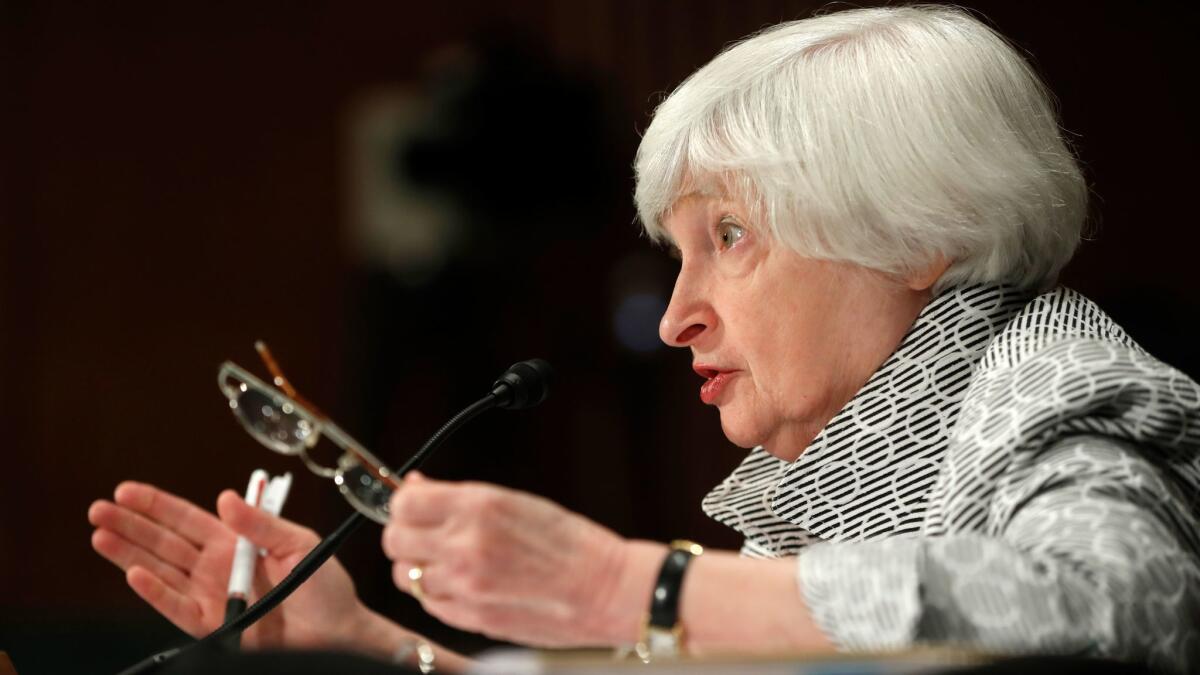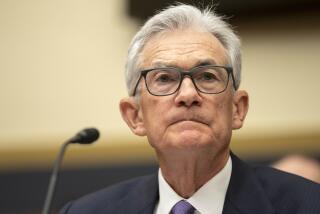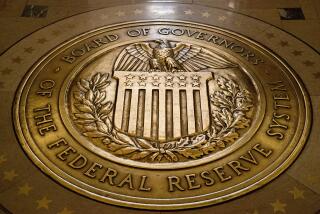Yellen defends Federal Reserve’s bond buying as the central bank starts reducing its stockpile

The Federal Reserve announced Wednesday that it would start slowly reducing the trillions of dollars in bonds it bought to stimulate the economy, another milestone in the central bank’s efforts to return to a normal monetary policy after the Great Recession.
The long-awaited reduction in the Fed’s $4.5-trillion balance sheet, to begin next month, comes amid a cloudy short-term economic outlook and great uncertainty at the central bank. There are several vacancies on the Fed board, and there could be a change in leadership early next year if President Trump decides not to renominate Chairwoman Janet L. Yellen.
At a news conference Wednesday, Yellen said that she had not met recently with Trump, and she declined to comment about a possible second stint as Fed chairwoman after her first four-year term expires in February.
Yellen also defended the controversial bond-buying effort begun under her predecessor, Ben S. Bernanke, which she said had helped the economy recover more quickly from the Great Recession of 2007-09.
With the recovery now “on a strong track,” the extra stimulus from the bond purchases is no longer needed, she said.
“I think that the American people should feel the steps we are taking to normalize monetary policy are ones that we feel are well justified given the very substantial progress we’ve seen in the economy,” Yellen said.
Earlier Wednesday, Yellen and her colleagues voted unanimously to leave the Fed’s benchmark short-term interest rate unchanged. They signaled another small rate hike is coming by the end of the year.
But the recent devastation caused by severe hurricanes could make it difficult for Fed officials to get a solid read on the economy in the coming weeks.
“Hurricanes Harvey, Irma and Maria have devastated many communities, inflicting severe hardship,” the Fed said in a policy statement Wednesday after its two-day meeting. “Storm-related disruptions and rebuilding will affect economic activity in the near-term, but past experience suggests that the storms are unlikely to materially alter the course of the national economy over the medium term.”
One short-term effect of the hurricanes will be higher gasoline prices, which “will likely boost inflation temporarily,” the Fed said.
Inflation has persistently run below the central bank’s 2% annual target, which has made the Fed hesitant to raise rates. Yellen described the low inflation this year as something of a “mystery,” even as she expressed confidence that the measure would move to the Fed’s desired level of 2% next year.
Economists say that negative short-term effects caused by the storms, such as a spike in unemployment claims by workers and shutdowns by businesses in the affected areas, usually are offset by a boost in economic activity when rebuilding begins.
Yellen said national employment numbers for September were likely to be affected by the hurricanes, but noted that she was “very pleased and heartened” by the continued improvement in the labor market in recent months.
Third-quarter economic growth also is expected to be dragged down by the storms, but Fed policymakers actually revised up their forecast for overall growth this year to 2.4% from a 2.2% projection in June.
And the actions taken Wednesday demonstrated their confidence that the economy will continue to grow moderately for the foreseeable future.
As expected, central bank officials voted to hold the benchmark federal funds rate steady at between 1% and 1.25%. But they still are forecasting another increase of 0.25 of a percentage point by the end of the year — a signal they think the economy remains on solid ground.
Their projections were the same as in June for the unemployment rate, which is forecast to be at 4.3% by the end of the year, and for inflation, which is expected to be at an annual 1.6% rate by the end of 2017.
Fed officials have been signaling for months that they planned to start reducing the Treasury bonds and mortgage-backed securities the central bank began buying in 2008. The purchases were supposed to stimulate growth by pushing down mortgage and other long-term interest rates.
Although economists have varying views about the effect of those purchases, Yellen said they were successful in stimulating the recovery. She cited a recent Fed study indicating that the series of bond purchases, which more than quadrupled the Fed’s balance sheet to $4.5 trillion, had the overall effect of lowering long-term interest rates by about 1 percentage point.
The Fed’s announcement Wednesday that it would begin the reductions next month was based on a detailed plan approved in June. The advanced telegraphing of the move was designed to avoid rattling investors, and financial markets have remained calm as the Fed anticipated taking another key step in reversing its unprecedented stimulus policies.
Financial markets took the news in stride Wednesday. That contrasted with the so-called taper tantrum in 2013, when markets convulsed after Bernanke, then the Fed chairman, indicated the Fed was getting ready to slow down the bond purchases.
Still, Brian Coulton, chief economist at Fitch Ratings, said that the unwinding of the Fed’s stimulus, along with a similar move expected by the European Central Bank next year, posed increased risks for the economy.
“Financial markets will have to get more and more used to the sucking sound of disappearing central bank liquidity over the next few years,” Coulton said. “No one really knows how that will pan out.”
The Fed plans to gradually allow an increasing amount of proceeds from maturing securities to be run off the central bank’s books each month. As the bonds mature, the government pays the face value to the Fed. The Fed would keep some of the proceeds instead of reinvesting them in new bonds.
The amount of proceeds would start at $10 billion a month and increase over the course of a year until they reach $50 billion a month.
Yellen reiterated Wednesday that the Fed intends to reduce its assets “in a gradual and predictable manner,” although policymakers have not specified a target level for how much it wants to shrink the balance sheet. The Fed also plans to keep raising its key interest rate, with most policymakers seeing at least three quarter-point rate hikes next year.
Yellen, however, emphasized as she has in the past that the Fed was not “locked in” to a set course and could stop reducing its assets if the economy began weakening. That view could change under a new Fed chief.
“Although this statement removes some of the uncertainty about monetary policy through the end of this year, there is still a great deal of uncertainty for 2018 and beyond,” said Gus Faucher, chief economist at PNC Financial Services.
There are three empty seats on the Fed’s seven-member board. Vice Chairman Stanley Fischer steps down next month, and Faucher thinks Trump will replace Yellen.
“The Federal Reserve Board, and monetary policy, could look very different next year,” Faucher said.
UPDATES:
3:10 p.m.: This article has been updated with comments from Federal Reserve Chairwoman Janet L. Yellen and additional details and reaction.
This article originally was published at 11 a.m.








